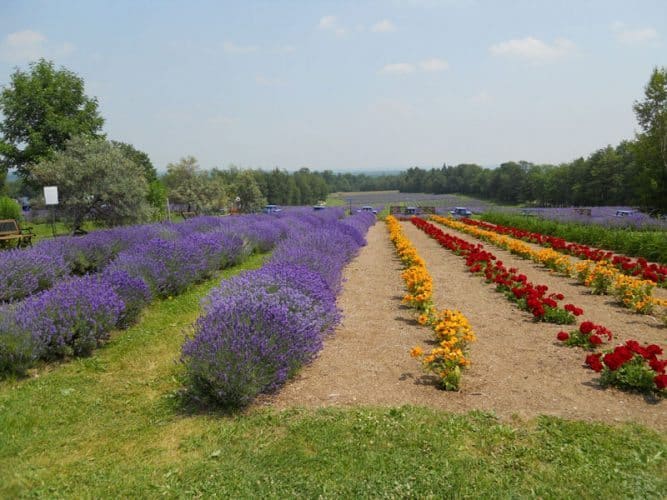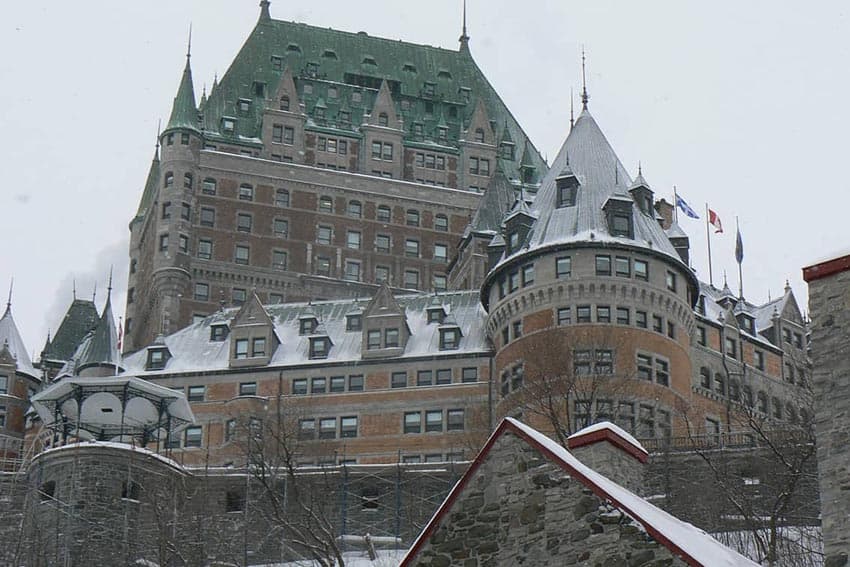
By Habeeb Salloum
Standing atop a 300 m (984 ft) high hill Domain Blue Lavender Farm (Bleu Lavande), just minutes from the charming town of Magog, edging the picturesque village of Fitch Bay in the Eastern Townships in Quebec, I breathed in the lavender-filled breezes.
Like myself, here, in the midst of fields of this aromatic herb one can, in an aroma filled dream, visualize a world of contentment, peace, freshness and calmness – a world without stress.
It is an area of lavender perfume, impregnating everything around. A symbol of patience and dreams, the farm is the culmination of many years of much research and intensive work.
The owners, Pierre Pellerin and his wife Christine Deschesnes, have created an area of peace, scents and scenery – an agritourism world that ensnares one with its magic. The farm is the only Canadian producer of lavender certified under international standards.
The largest lavender farm in Canada and the second largest in North America, it is covered with over 200,000 plants and it is still expanding. In the spring of 2010, a $4.2 million expansion was announced.

Pierre Pellerin, a thriving inventor and electrical engineer, was stressed out from overwork and related travel. He was ready to relax and to try something new –- this he did after purchasing 105 hectares (260 acres) on Fitch Bay –- yet not knowing quite what to do with them.
Initially thinking some spices might be the future, he considered, as well, growing lavender, in spite of being advised that the severity of Quebec’s climate would make it near impossible to grow the purple fragrant herb. However he went ahead with his fields and beat the odds.
Today, Pierre, nicknamed Monsieur Lavande, and Christine operate a flourishing tourist-oriented lavender farm and six other outlets in Quebec. It is a start to finish lavender business — from growing the plants to manufacturing and retailing produced products.
We toured the flowering fields, visited the interpretation center to learn about the history and farming of the plant, stopped at the distillery where the true lavender essential oil is extracted and lastly at the boutique, which carries a large number of products derived from 100% pure lavender.
We relaxed amid the fields, dined on a fine buffet meal while the breezes perfumed by lavender soothed our bodies, then capped the day by having our feet massaged with lotions and oils.

Bleu Lavande is not a unique modern project. The cultivation goes back at least 2,500 years when it was used for mummification and as a perfume by the ancient Egyptians and other peoples of the Middle East such as the Canaanites and Arabs. The Greeks and the Romans added to its spread by also using it to perfume their baths and bodies, as well as their cooking.
This plant oozing perfume was initially called narda after the Syrian city of Naarda, located close to the Euphrates river. Eventually, it became known to the Greeks as spikenard. Its present name comes from the Latin, ‘lavo’ meaning, ‘to wash.’
Lavender is mentioned a number of times in the Bible. In Luke’s gospel it is related: ‘Then took Mary a pound of ointment of spikenard, very costly, and anointed the feet of Jesus, and wiped his feet with her hair; and the house was filled with the odor of the ointment.’
Another story relates to the clothing of baby Jesus being impregnated with the scent of the plant. In later centuries, this story came to be regarded as holy, and lavender was used to guard against evil. Perhaps this legend also explains why, in the Middle Ages, lavender was hung over the doorway to guard against the devil.

Through the centuries, the use of lavender spread through Europe. By the 1600s its use had reached the Americas. All through the Medieval Ages, lavender was used as a cure-all in household medicine and to scent clothing.
Above all, in the medieval world, the special plant was employed as protection against the great plagues that swept through all of Europe a number of times during the Middle Ages.
The medievalist’s belief in the medical protection against the plague was no idle dream. The plague was carried by rats saturated with lice. Today it is used as a disinfectant and as a repellent for insects and lice. Others employ it as a potpourri in closets and furniture.
In the field of love and sex, in the past, women employed lavender as a perfume to attract suitors. In the Bible, Judith anointed herself with the perfume to seduce the enemy leader Holofernes. As well, in her web of wiles, Cleopatra employed it to seduce both Julius Caesar and Mark Anthony.
In Medieval England lavender tea was sipped by young ladies on St. Luke’s day to find the identity of their true Romeo. They’d chant, “St. Luke, St. Luke, be kind to me. In my dreams, let me my true love see.”

In the Europe of the Middle Ages, other ways of employing lavender in romance and love was by placing it in pillows in the hope of finding a love; and placing it under the bed of newlyweds to ensure passion. There are many medieval claims that lavender is helpful in arousing sexual appetite.
Today, the purple plant is widely used in the perfume industry. The Provence region in France is the world leader in producing it, and it is widely grown in England for commercial use.
Other countries including Canada and the U.S.A. produce it on a much smaller scale.
In the area of herbal medicine, lavender is widely used as an ingredient with other herbs, to induce sleep and relieve depression as well as for its relaxing and soothing qualities.
Compresses containing lavender are made for dressing wounds and applied to the forehead to relieve congestion of sinuses and headaches. You can even learn how to plant lavender at home.

In the modern culinary world, lavender also has a niche. The herb, much used as a spice in medieval Arab cooking, is very pronounced and if overdone it can overwhelm the taste of the dish.
It should be used only in tiny quantities to flavour such foods as baked dishes, jellies, sherbets and stews. As well, a healthy tea can be made from this historic perfume.
Thousands of visitors come every year to tour the Bleu Lavande Farm and enjoy its lavender offerings. The tourist business the owners have created is flourishing and their expansion plans call for continually renewing and diversifying the tourist facilities, offering new experiences and products.
The charming owners Pierre and Christine always greet visitors with smiles and hospitality, assuring them that their fields of lavender will help them relax and make them forget the stresses of the outside world.
Further Information:
Bleu Lavande
891 ch. Narrow, Stanstead (Fitch Bay)
Québec, Canada, J0B 3E0
Tel: 819 876-5851
Toll free number: 1 888 876-5851 (Canada)
Fax: 819 876-2574
E-mail: info@bleulavande.ca
Website: www.bleulavande.ca/home.htm
- El Salvador: Mayan Ruins and Scenic Landscapes - January 14, 2022
- Enchanted in Jarabacoa, Dominican Republic - March 5, 2019
- Ugarit, Syria: The Place Where Alphabets Began - September 26, 2017


